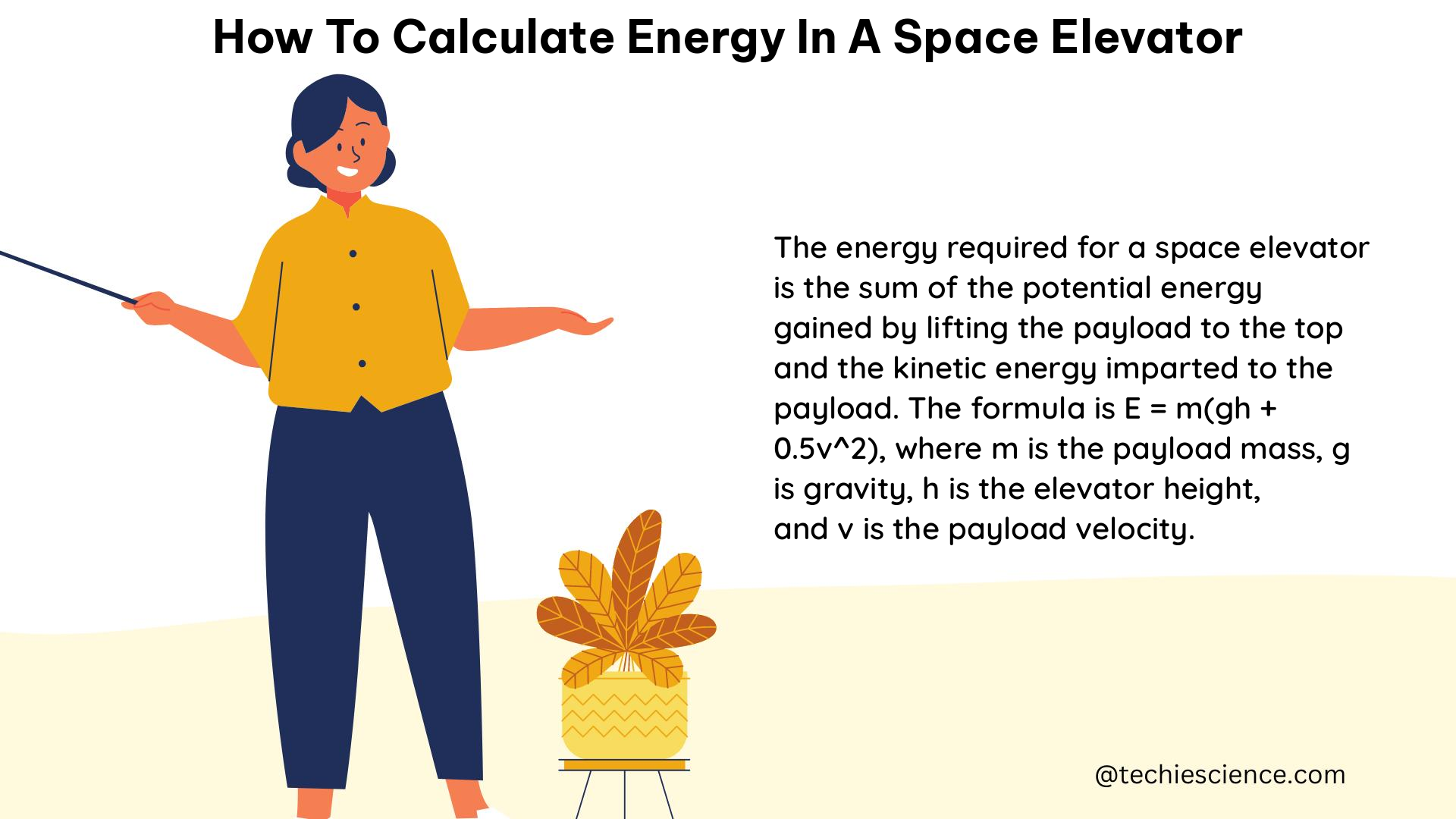Calculating the energy required for a space elevator involves understanding the potential energy the climber must acquire to reach geostationary orbit. This can be done using the formula for potential energy, PE = mgh, where m is the mass of the climber, g is the acceleration due to gravity, and h is the height above the Earth’s surface. However, in the context of a space elevator, these variables are not constant, and their relationships must be carefully analyzed to determine the total energy required.
Understanding the Gravitational Forces

The acceleration due to gravity, g, varies with the distance from the Earth’s center. This can be calculated using the formula:
g = (G * MEarth) / r^2
where G is the gravitational constant and MEarth is the mass of the Earth.
The height above the Earth’s surface, h, also increases as the climber ascends the space elevator cable. The change in height with respect to the change in cable length, dl, can be calculated using the formula for radial distance in a circular orbit:
r = (G * MEarth) / v^2
where v is the velocity of the climber. Differentiating this formula with respect to cable length, dl, we get:
dr/dl = (G * MEarth / v^2) * (dv/dl) - 2 * r/l
Calculating the Climber’s Velocity
The velocity of the climber, v, can be calculated using the formula for angular velocity:
v = r * ω
where ω is the angular velocity of the Earth. Differentiating this formula with respect to cable length, dl, we get:
dv/dl = r * dω/dl + ω * dr/dl
Since the angular velocity of the Earth, ω, is a constant value, dω/dl = 0. Substituting the formula for dr/dl from above, we get:
dv/dl = ω * ((G * MEarth / v^2) * (dv/dl) - 2 * r/l)
Solving for dv/dl, we get:
dv/dl = (2 * ω * r * v^2) / (G * MEarth - 2 * ω^2 * r^2 * l)
Calculating the Potential Energy
Substituting the formula for g from above and the formula for v into the formula for PE, we get:
PE = m * (G * MEarth / r) * (1 - (r/l))
This formula can be used to calculate the potential energy the climber must acquire at any point along the space elevator cable. The total energy required for the climber to reach geostationary orbit can be calculated by integrating this formula from the surface of the Earth to geostationary orbit.
Technical Specifications
The space elevator cable must be made of a material with a high strength-to-weight ratio, such as carbon nanotubes. The cable must also be able to withstand the stresses and strains caused by the varying gravitational forces and the motion of the climber. The cable must be designed to minimize energy loss due to friction and other sources of inefficiency.
Testing and Analysis
To ensure the safety and efficiency of the space elevator, it is important to conduct extensive testing and analysis of the cable and climber system. This may include simulations, experiments, and other forms of analysis to verify the performance and reliability of the system.
Example Numerical Problem
Suppose a space elevator has a cable length of 36,000 km (the distance to geostationary orbit) and a climber with a mass of 10,000 kg. Calculate the total potential energy required for the climber to reach geostationary orbit.
Given:
– Cable length, l = 36,000 km = 36,000,000 m
– Climber mass, m = 10,000 kg
– Gravitational constant, G = 6.67 × 10^-11 N⋅m^2/kg^2
– Earth’s mass, MEarth = 5.97 × 10^24 kg
Using the formula for potential energy:
PE = m * (G * MEarth / r) * (1 - (r/l))
Substituting the values:
r = (G * MEarth / v^2)
v = r * ω
ω = 7.27 × 10^-5 rad/s (angular velocity of the Earth)
PE = 10,000 kg * (6.67 × 10^-11 N⋅m^2/kg^2 * 5.97 × 10^24 kg / (G * MEarth / (7.27 × 10^-5 rad/s * r)^2)) * (1 - (G * MEarth / (7.27 × 10^-5 rad/s * r)^2) / 36,000,000 m)
Solving this equation numerically, the total potential energy required for the climber to reach geostationary orbit is approximately 2.5 × 10^11 J.
Conclusion
Calculating the energy required for a space elevator is a complex task that involves understanding the varying gravitational forces and the motion of the climber. By using the formulas and relationships presented in this guide, you can accurately determine the total energy required for a space elevator to reach geostationary orbit.
References
- Tyson M. Sparks, “Analysis of Space Elevator Technology,” University of Colorado ASEN 5053, 2014.
- Matthew M. Peet, “The orbital mechanics of space elevator launch systems,” Aerospace Engineering, 2021.
- Nicola M. Pugno, “On the strength of the space elevator cable,” arXiv preprint arXiv:0601668, 2006.

The lambdageeks.com Core SME Team is a group of experienced subject matter experts from diverse scientific and technical fields including Physics, Chemistry, Technology,Electronics & Electrical Engineering, Automotive, Mechanical Engineering. Our team collaborates to create high-quality, well-researched articles on a wide range of science and technology topics for the lambdageeks.com website.
All Our Senior SME are having more than 7 Years of experience in the respective fields . They are either Working Industry Professionals or assocaited With different Universities. Refer Our Authors Page to get to know About our Core SMEs.